How to Waterproof Leather? 6 Ways To Do It

Leather is a natural material that looks stylish and luxurious, but it’s not naturally waterproof.
To keep your leather items looking their best for years to come, you’ll need to waterproof them.
To waterproof your leather, you can use waterproofing sprays to wax or oil, there are many options available to you for protecting your leather goods. You can also use water-repellent sprays, waterproofing cream or conditioner, and even a waterproofing gel or lotion.
In this article, you’ll learn all about how to waterproof leather, its importance, and how to do it yourself.
You’ll also discover the benefits of waterproofing as well as tips for maintaining your precious leather items.
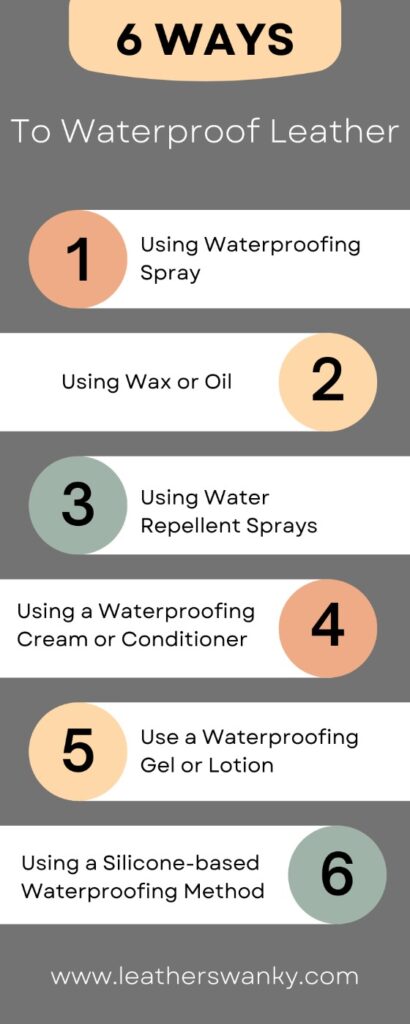
Jump to a Specific Section
- 1 Summary
- 2 Understanding the Importance of Waterproofing Leather
- 3 Different Types of Leather and Their Waterproofing Needs
- 4 Is Leather Waterproof or Water-Resistant?
- 5 How to Waterproof Leather? 6 Ways
- 6 Common Mistakes to Avoid When Waterproofing Leather
- 7 Benefits of Waterproofing Leather
- 8 How to Waterproof Suede and Nubuck Leather
- 9 How to Fix a Wet Leather
- 10 Additional Tips and Tricks
- 11 Final Thoughts
- 12 Frequently Asked Questions
- 12.1 How Often Should Leather Be Waterproofed?
- 12.2 What Is the Best Product to Use for Waterproofing Leather?
- 12.3 Is There a Way to Waterproof Leather Without Using Chemicals?
- 12.4 Are There Any Health or Environmental Risks Associated With Waterproofing Leather?
- 12.5 Can I waterproof a leather jacket?
- 12.6 What can I use to waterproof a leather bag?
- 12.7 What should I do if my leather gets wet?
- 12.8 Can I use any waterproofing solution on leather?
- 12.9 How often should I waterproof my leather?
- 12.10 Can I waterproof my leather boots?
- 12.11 Why is it important to waterproof leather?
- 12.12 Should I spot-test my leather before waterproofing it?
- 12.13 What types of leather can be waterproofed?
- 13 Resources Used for Research
Summary
- Different types of leather require different waterproofing treatments.
- Regular waterproofing maintenance is necessary to keep leather looking its best.
- Waterproofing methods only provide protection against light moisture exposure.
- Regular application of waterproofing products helps maintain leather quality.
Understanding the Importance of Waterproofing Leather
It’s important to waterproof your leather if you want to keep it looking its best.
Leather is a natural material that comes in many different forms, and each type of leather requires different types of care.
Waterproofing your leather is an essential part of keeping it in good condition as it helps protect the material from water damage.
If you have a leather jacket or bag, waterproofing them will help keep them looking their best for years to come.
When waterproofing your leather item, there are several things to consider.
- Different types of leather require different treatments when it comes to waterproofing, some may need special sprays or waxes while others can be treated with natural oils like olive oil or beeswax.
- It’s important to know what type of leather you have before applying any kind of treatment so that you don’t damage the material further.
To ensure optimal protection for your leather item, make sure you understand the needs specific to the type of material before beginning any kind of waterproofing process.
Different Types of Leather and Their Waterproofing Needs
You’ll need to consider the type of hide you have when determining how best to protect it from moisture. Different types of leather will require different approaches when waterproofing.
- Full-grain leather, for instance, is the most durable and usually requires only a wax-based conditioner to remain waterproof.
- Suede or nubuck leather must be treated with a spray-on water protector in order to remain fully waterproofed.
- Leather that has been processed into a different texture, such as pebbled or brushed leather, requires both wax and spray treatments in order to adequately waterproof it.
It is important to note that neither of these processes will make your leather completely waterproof; rather they are simply methods that can help protect your leather from light moisture exposure.
Is Leather Waterproof or Water-Resistant?
You may have heard the terms waterproof and water-resistant before when it comes to items like jackets, boots, or even leather goods.
It’s important to understand the difference between these two as they are not one and the same.
Waterproof items are impenetrable by liquids, while water-resistant items can only resist liquids up to a certain point.
Leather by nature is not a completely waterproof material. Too much water will damage the leather.
To waterproof leather, you need to use special sealants or waxes in order to make sure that all areas of the leather item are completely protected from moisture.
Waterproof
To waterproof leather, it’s important to use a special waterproofing treatment. Leather and water don’t mix, so you have to choose between waterproof or water-resistant methods for your leather items.
The right solution depends on the item and how often it will be exposed to wet conditions. There are various methods for waterproofing leather, such as using sprays or waxes.
When you apply a waterproofing solution to your leather bag, make sure you use an even coating for optimal protection from moisture. Waterproofing is necessary if you want your bag to last in any weather condition.
Water Resistant
Water resistance is an important factor when it comes to protecting leather items from moisture. Consider using a leather cleaner, waterproof spray, and a waterproofing agent for full-grain leather pieces.
How to Waterproof Leather? 6 Ways
You want to make sure your leather items are well protected from water and other elements. You can do that by waterproofing them with a variety of different methods.
All of these methods will help keep your leather safe from the elements while ensuring it looks great too.
1. Using Waterproofing Spray to Leather
Spraying your leather with a waterproofing spray is an easy way to protect it from the elements.
Whether you have a genuine leather jacket or real leather shoes, applying the spray will create a waterproof protective barrier that prevents rain and moisture damage.
Here’s what you need to do:
- Choose a waterproofing spray specifically designed for leather items.
- Clean the item thoroughly before application.
- Follow the directions of the product closely as some require multiple layers for full protection.
- Allow each layer to dry completely before applying another one. Using a waterproofing spray on your leather items is simple, fast, and effective when done properly.
It helps keep them looking good and lasting longer by protecting them from water damage caused by rain or snow.
2. Using Wax or Oil to Waterproof Leather
Wax and oil waterproofing products are ideal for grain leathers, as they seep into the fibers of the material and bond with the oil molecules already in the leather.
When doing this, it’s important to thoroughly clean and dry the material before application. Once applied, allow the leather to dry completely before use.
The best way to apply wax or oil is with a soft cloth or buffing brush; rub it gently into the fabric until evenly coated.
This will help ensure complete coverage and create an effective waterproof barrier on your leather goods.
3. Using Water Repellent Sprays
To protect your leather goods from water damage, consider using a water-repellent spray.
It’s an easy and quick way to waterproof leather and remains effective for several months after application.
Here are some items to keep in mind:
- Faux leather is not the same as genuine leather and should be treated differently when applying a water-repellent spray – faux leather may require more applications or specific sprays.
- Genuine suede leather needs special attention when it comes to waterproofing with sprays – use a product designed specifically for suede materials.
- When applying any kind of spray to genuine or faux leather, always test it on an inconspicuous spot as certain sprays can discolor the material.
- Be sure to follow all instructions provided by the manufacturer of the product you choose. This will ensure that your item is properly protected without damaging it in any way.
4. Using a Waterproofing Cream or Conditioner
For an extra layer of protection on your leather goods, try using a waterproofing cream or conditioner.
This is an ideal way to ensure your top-grain and full-grain leather items stay water-resistant and look their best.
Before you start applying the product:
- Make sure to clean the item thoroughly with a damp cloth or leather care solution first.
- Once it’s dry, apply the waterproofing cream or conditioner in smooth strokes that cover all surfaces evenly.
- Allow the product time to absorb into the leather before wearing it and be sure to reapply whenever necessary for optimal results.
With the proper use of a waterproof protective cream or conditioner, you can keep your leather items looking great for years to come.
5. Use a Waterproofing Gel or Lotion
Try using a waterproofing gel or lotion for extra protection on your leather items, it’ll help keep them looking great.
To apply, simply rub the gel or lotion on the surface and let it dry. Here’s what you need to know about this method:
- Provides a thin protective layer
- Seals pores in the leather, preventing moisture from seeping in
- Permanently waterproofs leather surfaces without damaging them
- Will not change the color of your leather item
6. Using a Silicone-based Waterproofing Method
A silicone-based waterproofing method is an effective way to protect your items without altering their color.
This method works best on leather goods, such as jackets or boots, and is a great way to waterproof a leather jacket.
Before you start, make sure that you are familiar with the type of leather you are working with so you know which products will work best.
The benefits of waterproofing leather are plentiful, it prevents water damage and helps maintain the item’s original condition for longer periods of time. It can also be used on synthetic leathers as well as natural ones.
When applying the product, use a soft cloth and follow the instructions carefully to ensure proper application.
Be sure to apply several coats for maximum protection and allow each coat to dry completely before adding another layer.
Common Mistakes to Avoid When Waterproofing Leather
It’s easy to make mistakes when waterproofing leather, so don’t let it happen to you.
Here are the common missteps to be aware of:
- Applying a waterproofing agent on nubuck or natural leather. Avoid using any type of chemical-based product on these types of leather as it may lead to discoloration and damage over time.
- Not prepping the surface before waterproofing your leather jacket or boots. Cleaning the item thoroughly and allowing it to dry completely is essential for optimal protection.
- Not conducting a patch test before proceeding with full application. Always try out a small area first in case the product is incompatible with your specific item of clothing or footwear.
- Using excessive amounts of product when trying to protect leather items from water damage. Too much can leave behind an unpleasant white residue that will require more effort to remove than necessary.
Benefits of Waterproofing Leather
Waterproofing your shoes and jackets can provide many great benefits, so don’t miss out. When wet leather is not treated properly, it can begin to crack and break down over time.
- Waterproofing your leather items will make the leather more durable and long-lasting.
- A waterproof protective coating helps protect the leather from dirt, water, and other weather elements.
- Also helps to preserve the original color and texture for years to come.
- Leather items will last longer even when exposed to moisture or wet environments.
- If you live in an area with frequent rain or snowfall, having a waterproof layer on your clothing or accessories can help them stay looking new for much longer periods of time.
- When using the item outdoors for activities such as hiking or camping, it’s essential that you know how to waterproof the item beforehand in order to keep it safe from any potential damage due to water exposure.
- Additionally, applying a waterproof coating can also help enhance the overall look and feel of your items by providing a glossy finish that adds shine and depth to their appearance.
Finally, knowing how to properly care for and maintain your leather goods with a layer of protection ensures that they remain in optimal condition for years of use.
How to Waterproof Suede and Nubuck Leather
Protecting your favorite suede and nubuck leather items is important for keeping them looking great.
Here are some tips to help you waterproof them:
- Start by cleaning the leather and removing any dirt or debris. This will allow the leather to absorb the natural waterproofing solution.
- Next, spot-test your leather in an inconspicuous area to make sure it won’t discolor or damage the piece.
- After that, apply a thin coat of a natural waterproofing solution all over the surface of the item, making sure to get into creases and folds as well. Allow it to fully dry before applying another layer if necessary.
- Finally, keep building up the waterproof protective layers until you’ve reached your desired level of protection.
However, keep in mind that suede and nubuck can never be completely waterproofed due to their porous nature.
How to Fix a Wet Leather
Fixing wet leather can be tricky, but it’s possible with the right techniques.
Here are some tips to help preserve your leather:
- Start by removing as much of the water as possible from the surface with a dry cloth.
- Apply saddle soap or gentle leather cleaner and conditioner to nourish and soften the leather.
- Allow your leather to air dry away from direct heat or sun exposure.
- Ensure that your leather is properly treated with a waterproof sealant.
Leather care is to preserve and protect against water damage so take precautions when you’re out in wet weather, this will ensure that your leather dries quickly and without damage.
Additional Tips and Tricks
Applying a waterproofing product regularly can help keep your leather in great shape. The type of leather and the quality of the leather will determine how long it remains waterproof.
Full-grain and top-grain leather are usually more durable and resistant to water damage when compared to other types of leather.
However, if you don’t take proper care of your leather items they can become ruined by water damage.
Final Thoughts
Waterproofing your leather items is a great way to protect them from water damage so they last longer.
It’s also important to remember that suede and nubuck leather require special attention when it comes to waterproofing.
Finally, don’t forget that wet leather can cause irreversible damage to your favorite items, so be sure to act quickly
if your leather gets soaked in water or other liquids! With these tips in mind, you’re sure to keep your leather goods looking as good as new for years.
Frequently Asked Questions
How Often Should Leather Be Waterproofed?
Leather should be waterproofed at least once a year, or whenever it starts looking dry and brittle. Doing this regularly will help keep your leather goods in top condition and protect them from the elements.
What Is the Best Product to Use for Waterproofing Leather?
Do you want the best product for waterproofing leather? Look for a spray-on or cream-based waterproofer designed specifically for leather. It should be easy to apply and protect your leather from dirt, water, and stains.
Is There a Way to Waterproof Leather Without Using Chemicals?
Yes, you can waterproof leather without using chemicals. You can use oils and waxes to protect the material from water damage. These natural products will provide a layer of protection while still preserving the leather’s softness and breathability.
Are There Any Health or Environmental Risks Associated With Waterproofing Leather?
Yes, there can be health and environmental risks associated with waterproofing leather. Chemicals used in waterproofing can emit fumes that are hazardous to breathe in or have long-term effects. Look for natural, eco-friendly options to reduce risk.
Can I waterproof a leather jacket?
Yes, you can definitely waterproof a leather jacket. Leather jackets are often exposed to moisture, so waterproofing them is a smart way to protect them from water damage and stains.
What can I use to waterproof a leather bag?
There are various methods for waterproofing leather bags. You can use a leather conditioner or leather wax to create a waterproofing layer on the surface of the bag. Additionally, there are waterproofing sprays available specifically for leather products.
What should I do if my leather gets wet?
If your leather gets wet, the first thing you should do is gently pat it dry with a soft cloth or towel. Avoid using heat sources like hair dryers, as they can cause the leather to dry out and crack. Let the leather air dry naturally in a well-ventilated area.
Can I use any waterproofing solution on leather?
It’s important to use a waterproofing solution or agent that is specifically designed for leather. The composition of leather is unique, and using the wrong product may cause damage or alter the appearance of the leather.
How often should I waterproof my leather?
The frequency of waterproofing your leather depends on its usage and exposure to moisture. It is recommended to apply a waterproofing treatment every few months or when you notice the leather is becoming less resistant to water.
Can I waterproof my leather boots?
Yes, you can waterproof your leather boots using a leather waterproofing solution. Applying a thin and even layer of the waterproofing solution will help protect your boots from water damage and extend their lifespan.
Why is it important to waterproof leather?
Leather is a porous material, meaning it naturally absorbs water and moisture. Waterproofing your leather products creates a protective barrier that prevents water from penetrating the surface, keeping the leather dry and resistant to stains.
Should I spot-test my leather before waterproofing it?
It is highly recommended to spot-test your leather before applying any waterproofing product to the entire surface. This involves applying a small amount of the product to an inconspicuous area of the leather and checking for any adverse reactions or changes to the leather’s appearance.
What types of leather can be waterproofed?
Most types of leather can be waterproofed, including full-grain leather and top-grain leather. However, certain types of leather, such as suede or nubuck, require specific waterproofing methods and products. It is essential to check the manufacturer’s instructions or consult a professional before waterproofing these types of leather.
Resources Used for Research
- Study of the effect of temperature, relative humidity and UV radiation on chrome-tanned leather ageing
- Mechanical properties and preferences of natural and artificial leathers, and their classification with a focus on leather for bags
- General principles of care, storage and display
- Caring for Leather, Skin and Fur
- Care of Leather Materials
- Leather used in Furniture Upholstery
- The care of leather
- The manufacture of leather
- Conservation of leather and related materials

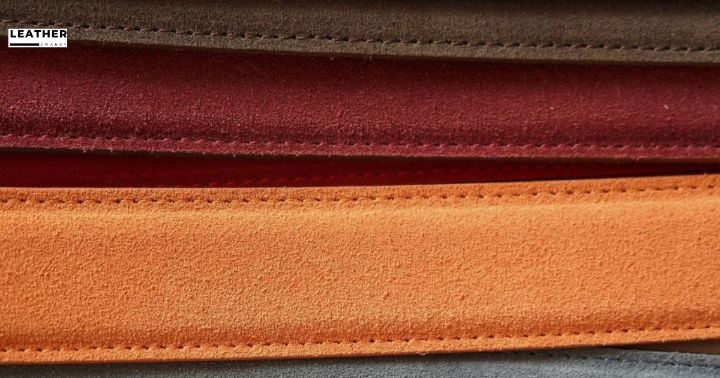
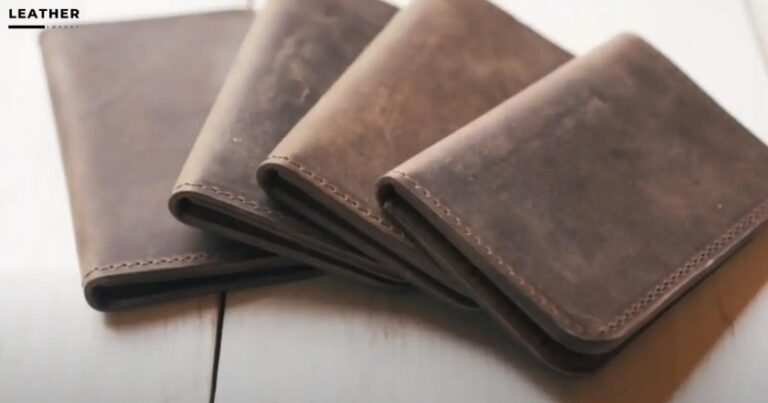
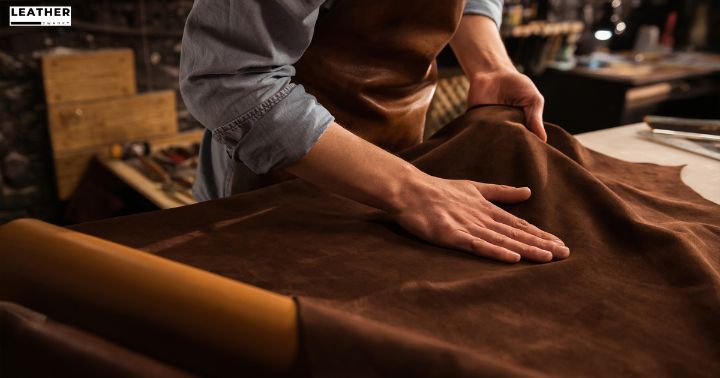


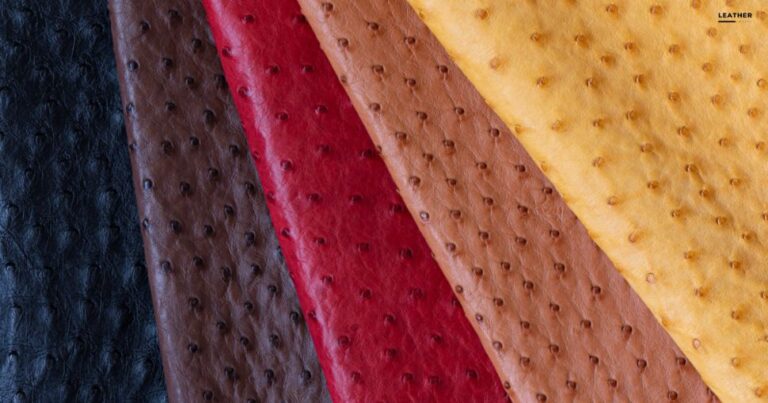
An extremely interesting examine, I might not agree completely, but you do make some very legitimate factors.
Thanks for the great post. I am anticipating some different ideas from your side. You constantly present some fresh thoughts in your posts.
I think you have remarked some very interesting points , regards for the post.